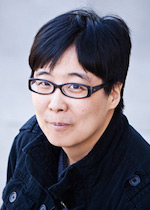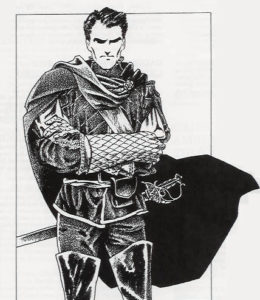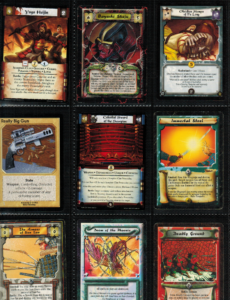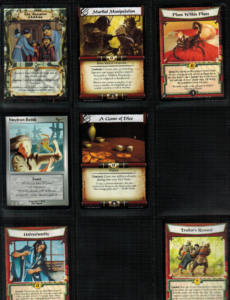Guest Post – Yoon Ha Lee: Tarot (and Other) Cards as Writing Inspiration
 Yoon Ha Lee is a Korean-American SFF writer. He has published short fiction in Fantasy & Science Fiction, Clarkesworld, Lightspeed Magazine and elsewhere. Three of his stories have been reprinted in Gardner Dozois’ The Year’s Best Science Fiction anthologies. Yoon’s new novel Nine Fox Gambit is out now from Solaris.
Yoon Ha Lee is a Korean-American SFF writer. He has published short fiction in Fantasy & Science Fiction, Clarkesworld, Lightspeed Magazine and elsewhere. Three of his stories have been reprinted in Gardner Dozois’ The Year’s Best Science Fiction anthologies. Yoon’s new novel Nine Fox Gambit is out now from Solaris.
My first exposure to Tarot was through science fiction, specifically Piers Anthony’s books. I can’t remember which one–I think he used the imagery in a number of his novels–but I liked playing cards and I was fascinated by the symbolism. It wasn’t until I got my hands on Roger Zelazny’s Chronicles of Amber, however, that my interest in Tarot really took off–and it wasn’t just the novels, it was Erick Wujcik’s Amber Diceless Roleplaying.
In Zelazny’s books, the royal family of Amber can be called upon by their Trumps or portrait cards. Even better, Amber Diceless Roleplaying wrote up Zelazny’s major characters as potential non-player characters (NPCs) and included beautiful black-and-white illustrations of their Trumps by Michael Kucharski. (I have a crush on Corwin’s portrait.) The idea of having characters represented by cards never left me.
 Over the years I have amassed a very small collection of Tarot decks, from the grunge-flavored Darkana Tarot (the Wheel of Fortune is a revolver, and it has an extra card, the Badass) to Nathan Never’s science-fiction-themed Tarocchi del Futuro, and even a Tarot Ambre (a gift). At some point in the future I’m hoping to treat myself to a copy of Stephanie Pui-Mun Law’s Shadowscapes Tarot as well. When I’m stuck on a story, sometimes I dig one out and do a Tarot spread to help myself brainstorm.
Over the years I have amassed a very small collection of Tarot decks, from the grunge-flavored Darkana Tarot (the Wheel of Fortune is a revolver, and it has an extra card, the Badass) to Nathan Never’s science-fiction-themed Tarocchi del Futuro, and even a Tarot Ambre (a gift). At some point in the future I’m hoping to treat myself to a copy of Stephanie Pui-Mun Law’s Shadowscapes Tarot as well. When I’m stuck on a story, sometimes I dig one out and do a Tarot spread to help myself brainstorm.
One might consider this a very advanced form of fox-waxing. My favorite way to do this is to focus on a character so that I can get a sense of their story arc, especially in a longer work. Half the fun is poring over the set of cards and deciding what card should serve as the character’s significator. For example, when I was working on the first two hexarchate books, I thought of General Shuos Jedao as the Knight of Swords. Of course, then I went on to do a reading for him using an app where you don’t choose the significator, it just shuffles the whole spread, and freaked out when the Knight of Swords turned up in the “self” position anyway. I try not to be superstitious, but this doesn’t help!
 I play pretty fast and loose with the spread, but sometimes the cards that look the most counterintuitive are the ones that make me think the hardest. Sometimes I reject what the spread tells me and go with something else. I mean, who’s going to stop me? Still, having a randomized source of archetypes to apply to my plots gives me a starting point.
I play pretty fast and loose with the spread, but sometimes the cards that look the most counterintuitive are the ones that make me think the hardest. Sometimes I reject what the spread tells me and go with something else. I mean, who’s going to stop me? Still, having a randomized source of archetypes to apply to my plots gives me a starting point.
As you can tell, I am not a Tarot expert; I do my best not to apply this stuff to real life. I often have to look up the meanings of the cards. But sometimes even that isn’t necessary–the pictures on the cards are enough to suggest to me what I want to do with my characters. It’s one of the reasons I collect different decks, because the art is different on all of them, and suggests different things to me.
I use a variant of this with collectible card game (CCG) cards, largely because my husband and I are sitting on a collection of them. (Misspent youth.) I pulled the ones  with pretty, evocative art and put them in those plastic binder pages, arranging them to create a sort of associational portrait of the character. Here are some examples, mostly Legend of the Five Rings with a side of Shadowfist. Legend of the Five Rings works for me because it was one of the inspirations for the hexarchate setting, but you could probably find something out there for anything.
with pretty, evocative art and put them in those plastic binder pages, arranging them to create a sort of associational portrait of the character. Here are some examples, mostly Legend of the Five Rings with a side of Shadowfist. Legend of the Five Rings works for me because it was one of the inspirations for the hexarchate setting, but you could probably find something out there for anything.
Other repurposed CCGs I have lying around include Blood Wars, Star of the Guardians, and Babylon-5 Wars. I imagine that if you write fantasy, you could get a lot of mileage out of Magic: The Gathering. My local game store sells old commons and uncommons for fifty cents apiece, and the beautiful thing about nabbing cards for the art rather than their play value is it’s not hard to find old, cheap commons that will do the job!



















 Full Details
Full Details


2 Comments
Samuel R. Delany’s Nova is another novel that makes extensive use of the tarot…
The RPG Everway had a Tarot-influenced Fortune Deck, which players used to define the influences on characters and worlds, as well as determine the outcomes of different kinds of conflicts, exchanges, and encounters. It also had image cards for generating character backstory. Great images on both, and we used to do the same storyboarding for characters and worlds using plastic binder pages.
Sorry, the comment form is closed at this time.